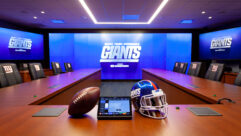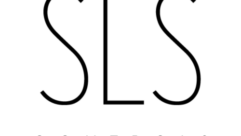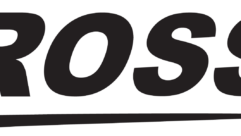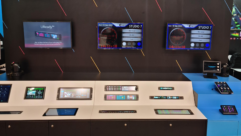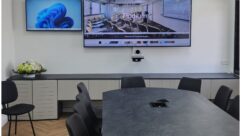
The Buzz: Installation Spotlight: Steiner Studios Screening Room, New York
Jan 1, 2007 12:00 PM,
By Trevor Boyer
Screening Dailies at “Hollywood East”

McCann Systems designed a custom 19ft.-wide, perforated video screen with side masking for Steiner Studios’ screening room.
Deep within the once-crumbling Navy Yard complex in Brooklyn, N.Y., is a screening room where Hollywood directors, producers, and editors convene. There they view filmed “dailies” — the fruits of their production teams’ daily labor at Steiner Studios, a 27,000-square-foot facility with five soundstages. (This past summer, for example, Disney’s Enchanted was filmed at the studios.)
Steiner Studios opened in fall 2004 as the biggest film studio east of Los Angeles, though it was still somewhat under construction. As of early 2006, its screening room was unfinished, lacking an AV system suitable for a soundstage facility nicknamed “Hollywood East.” With that in mind, McCann Systems of Edison, N.J., integrated the audio, film/video, and control systems of the 100-seat screening room in spring 2006.
In the process, McCann did a good deal of custom designing and building, starting with the room’s focal point, the 19ft. projection screen. Perforated to allow the installation of speakers behind it, the screen has a cinematic 2:35 aspect ratio. McCann designed a mechanical side-masking system for the screen, which it programmed with automatic steps for other common aspect ratios, down to 4:3.

Two Middle Atlantic AV racks and a dock for a wireless Crestron touchpanel are housed in the projection booth.
For film projection, McCann located two pre-owned Strong International Simplex 35mm projectors. Steiner also required a digital projection system for the screening room, so McCann chose an NEC iS8 model with three DLP chips that provide a resolution of 2048×1080, suitable for 2K digital cinema projection.
“The technical goal was to ensure that we got as close to cinema quality as we could with the DLP system,” says McCann project manager Joe Fusaro. “Because there are two 35mm projectors and you can run film, you want to have the DLP as close to that as you could. We found that the NEC iS8 model had the ability to have a cinema-grade chip in it, which gives the video more of a 35mm feel.” The NEC iS8 can be calibrated to meet Technicolor’s standards for color temperature and light output.
The screening room had been acoustically damped before McCann started work on the project. Steiner Studios knew it wanted to use a cinema series of JBL speakers that would conform the room to a specific Hollywood reference for movie theaters. Three 3632 (main, center, right), two 4642A (subwoofers), and a dozen 8340 speakers (surround) comprise a full 7.1 surround sound system running on Dolby CP650 and DMA8 processors. Crown Audio amps (CL2, CL4, and CL1) power the speakers.
Besides the theatrical system, McCann also installed antennas and four wireless microphones from TOA and a Clear One XAP 800 teleconferencing system for communications.
McCann designed the control system for the room and integrated three Crestron Electronics panels: a TPS-3000 at the director’s console at the center of the seating, a TPS3100LB at the podium at the front of the room, and a roving WiFi tablet (Isys i/O TPMC-10) that docks in the projection booth. McCann designed the control interface so that Steiner clients can walk into the room and control everything intuitively. “You can fire up the digital projector, select your sources, adjust volume, inputs, everything, and the lights as well,” Fusaro says.
McCann Systems custom-built the director’s console, which features the Crestron panel, a mic for communicating with the projection booth, and an AV pop-up from Extron Electronics that conceals video game and laptop connections. These can serve as sources for the AV system as well for viewing PowerPoint or video files housed on laptops. The lectern near the screen is also custom-designed, with similar laptop and microphone capabilities via a floor box. The tightness of the projection booth was a particular challenge for McCann. The necessary placement of the NEC projector between the two film projectors made it difficult to load the latter two with reels. “What we had to do was devise a means to move the [digital] projector out of the way so we could just run the reel-to-reel projector, and then have an easy means of putting it back into place without having to do a whole realignment,” Fusaro says. So McCann designed a wheeled cart for the NEC unit that connects to a positive locking mechanism at the front wall.
In the projection booth are two Middle Atlantic racks full of AV gear. The racks house sources for the projectors, such as a Sony SLV-D560P VHS/DVD combo player and a Sony DSR1800A DVCAM deck. To view dailies at resolutions higher than what these standard-definition sources allow, however, film production teams typically send out their film for developing, and Technicolor processes prints, digitally scans them, and saves them onto a portable hard drive.
“Now that hard drive — you just plug it into the computer that’s onsite, and then you’re able to play back the dailies digitally,” Fusaro says.


